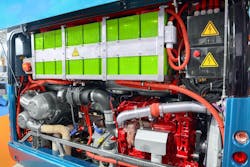Optimize Your Vehicle by Cooling Electric Motors and Generators (.PDF Download)
Plug-in electric vehicles for passengers continue to become more mainstream within the automotive market, and the shift in that direction shows no signs of slowing down. In fact, Bloomberg New Energy Finance’s 2017 Long Term Electric Vehicle Outlook forecasts that by 2040, 54% of new car sales and 33% of the global car fleet will be electric vehicles. Growth projections for the numbers of hybrid electric vehicles are similarly vigorous. However, what may be less obvious is the similar trend in commercial vehicle markets, including off-highway/construction equipment, agricultural vehicles, turf vehicles, and vehicles used in mining and forestry.
When developing a new electric or hybrid electric vehicle, one of the biggest design challenges is developing a thermal-management system for the vehicle.
Manufacturers of these vehicles are increasingly eager to develop and launch hybrid and electric products in an effort to reduce fuel consumption, particulate emissions, and noise levels, while improving vehicle performance, efficiency, reliability, and lifespan. Cooling an electric motor boosts its performance, allowing for a smaller motor to be used, which in turn lowers vehicle weight and increases energy efficiency.
Sizing the motor depends directly on how it is cooled. This article presents an overview of some of the thermal-management considerations involved in selecting the most appropriate cooling approaches for electric traction motors and auxiliary function motors for new off-highway electric and hybrid electric vehicles.
When developing a new electric or hybrid electric vehicle, engineers must weigh a variety of design tradeoffs and considerations when selecting electric motors/generators. One of the biggest challenges is developing a thermal-management system for the vehicle that meets the overall project’s space, weight, and cost targets. Depending on the vehicle design, the system may need to cool an internal combustion engine (ICE), traction motors/generators, inverters, batteries, and, in some cases, auxiliary function motors to power hydraulics, air-conditioning compressors, and brake compressors.

